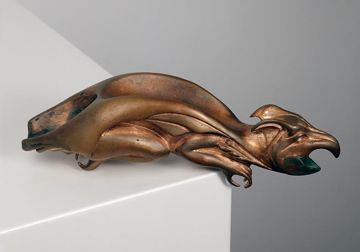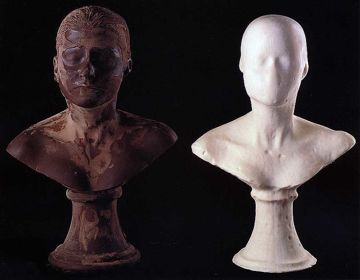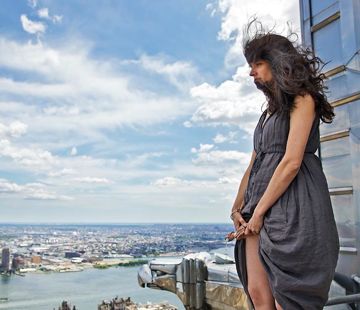
Janine Antoni, "Conduit" (detail), 2009. Courtesy Luhring Augustine Gallery.
To say it was a pleasure to be given the opportunity to interview Janine Antoni for this column is a gross understatement. In 2003, Janine Antoni‘s Season 2 segment was my first introduction to Art21. It’s no surprise that I’ve been hooked since. As an art educator who, at that time was quite frustrated with the lack of quality programming related to visual artists working today, this series seemed a little too good to be true. Fifteen minute segments in hour-long episodes? Educators’ Guides? Someone who answers the phone when I call? It was absolutely bizarre. Fast-forward six years and here we are, talking about a wonderful conversation for a column called Teaching with Contemporary Art.
Janine Antoni’s work, although it’s featured in the episode titled Loss and Desire, is also related to many of our new Season 5 themes. Specifically we discussed the themes of Systems, Transformation and Fantasy as they relate to her work. We also discussed her work as a teacher, her experience as a young artist, her new show at Luhring Augustine, and possibilities moving forward.
The following conversation took place this past September 16th. Part Two will be featured in next week’s column.
Joe Fusaro: I was wondering about your own art education growing up. What was it like for you to study art as a teenager and then go to both Sarah Lawrence College and the Rhode Island School of Design?
Janine Antoni: I grew up in the Bahamas, so I didn’t grow up going to galleries or museums. I basically came to art through craft. I was always making things, with stuff I found on the beach or in the woods. As a family we used to make things together, from Christmas decorations to objects to sell at the church fair. In high school, I made stage sets for theater productions. I am sure this experience has played into my interest in installation. College was my first introduction to contemporary art and I remember being really challenged… and disturbed. It turns out that the art that bothered me the most at that time was made by some of my favorite artists now. This fact has changed my perspective about my judgment. Now when I see something I really don’t like, I take note because it might be triggering something that is worth paying attention to.
JF: Is there a particular work or artist that you initially didn’t like and now love for some reason?
JA: Richard Long comes to mind. I used to think that art had to be beautiful in a traditional way. I remember thinking, “this guy picks up a rock, walks with it for two miles, sets it down in a gallery, and that’s an art work?” It seemed strange to me, but now I can relate it to a way of extending the tradition of the figure in the landscape and our relationship to space. I compare his approach to the brutality of certain earthworks and it seems like such a gentle intercession into the landscape. It is a poetic and truly beautiful gesture.
JF: What was RISD like?
JA: Can I step back and talk about Sarah Lawrence College first?
JF: Sure.
JA: At Sarah Lawrence College, I had a very classical training. I painted the still life and sculpted the figure. At RISD, I discovered conceptual art. It was like changing religions! I realized I could allow my ideas to dictate what I wanted to make and not be bound by predetermined forms or materials. I take on a variety of media and ways of speaking, but it’s really the same ideas that haunt me. I studied with Mira Schorr, who introduced me to Hannah Wilke, Ana Mendieta, and Carolee Schneeman, artists that weren’t canonized at that time by the culture or art history. I was also working with Thomas Lawson, who taught me about Sherrie Levine, Cindy Sherman, and Barbara Kruger. Looking back, I realize that when I started my career, I was picking up on a thread that was left open in work from the 1970s. I was instantly attracted to the visceral language of the 1970s, but was able to look at it through the lens of feminist ideas from the 1980s. So I wound up locating myself between those two sources.

Janine Antoni, "Lick and Lather" (detail), 1993. Courtesy the Artist and Luhring Augustine Gallery.
JF: Your Art21 Season 2 segment is shown as part of the Loss and Desire hour, but your work also relates to the Season 5 themes of Systems, Transformation, and Fantasy. Do you agree that your past and present work relates to these themes and if so, which of the three do you feel is most on your mind these days?
JA: Well, let’s start with the one I don’t understand, which is Systems. Can you tell me about the artists featured in that segment?
JF: The artists featured in Systems this year include John Baldessari, Allan McCollum, and Julie Mehretu. When I think about the organization of your individual works, I think about Cradle, and perhaps the process you went through to create Lick and Lather, as well as the way it’s presented to the viewer. But it sounds like Systems is not one you feel close to?
JA: At first I was going to say no, but then you mentioned Allan McCollum. He’s been a huge influence, even though I certainly don’t work with systems in the way he does. I appreciate the rigor and lengths he will go to in order to play out an idea. I am also thinking about John Cage, because his chance operations established a system that he would stick to, regardless of the outcome. The result was the work. I am challenged by this approach and feel that this is precisely what makes his work so innovative, and important.
My art certainly engages different types of transformation. To start with, I make the work because I want to go through a personal transformation through the process. I guess this motivation is what gets me into challenging situations. I have a superstition that if I go through a transformation, then perhaps the viewer will as well. That may be too much to ask for, I admit, but I try to make work that is moving. I often end up giving myself over completely to the process. I want the challenge on all levels: physical, emotional, intellectual. The work is requiring something of me that at first I am resisting, and yet I keep returning to.
When it comes to materials, I am fascinated by their transformation as a result of the process. I aim for an intimate relationship with my objects, and I always hope the viewer can sense that intimacy from their surfaces. I feel like I get close to the viewer through the mediated object, but that just may be my fantasy… So what was the third theme?
JF: That’s it—Fantasy.
JA: You know, we talked about schools but I haven’t mentioned anything about my experience as a teacher now. I teach at Columbia. I like to talk to my students about the importance of fantasy, because I think we all have a secret conversation with an imaginary viewer in our mind when making. This imaginary viewer could be modeled on a mentor, favorite artist, a best friend—or it might just be an ideal projection of a part of oneself. This is something that I like to encourage, because I think it’s healthy in the artmaking process to hone in on that specific dialogue. Then there are the more concrete fantasies in my work—like the desire to pee off a skyscraper, or chew on 600 lbs of chocolate (laughs). These are the crazy fantasies that I am allowed to live out in the name of art! I want to engage my own and the other’s imagination as though we were meeting somewhere in the unconscious. That is the space of art. It’s why I like Bruce Nauman. He seems to be a direct conduit into a particular place in my unconscious. It’s almost like I can recognize his work because I’ve experienced it in a dream. He seems to take me to that same place every time. I need him for that because I can’t access that place on my own.

Janine Antoni, "Conduit" (detail), 2009. Courtesy Luhring Augustine.
JF: It’s interesting that you mention Bruce Nauman. Your new work at Luhring Augustine, titled Up Against, has been described as “continuing your exploration of the body as measure.” I was wondering if you could talk more about that.
JA: By measure, I mean the way that I understand or relate to the world. It is a constant effort for me to be in my body. Contemporary culture has had a severing effect. Our exploitation of the environment is just an extension of how we exploit our own bodies. It is very easy to treat one’s own body like a machine, or as a mere vehicle of the mind. Emotions are first felt within the physical body, but because of our mental fear of dealing with our emotions, we cut ourselves off from the body. I think our memories are held in our bodies, and they get locked in there. Sometimes the only way to retrieve them is through the body. The more I listen to the way my body reacts to the world, the more it changes the way I live my life. I guess I have come to trust my body more than my mind because it doesn’t play tricks on me.
Be sure to catch part two of this interview next week on Wednesday, October 14th.




Pingback: Teaching with Contemporary Art: The First Three Years | Art21 Blog
Pingback: Reblogged from sippor: Janine Antoni, Saddle, 2000 New interview with Janine Antoni PBS has a huge s | CLARE YOW
Pingback: Talking with Janine Antoni and Getting Set for NAEA: Part One | Art21 Blog
Pingback: Materials Performing/Performing Materials: transitive, transformative, ephemeral and invisible materials « Sculpture: Materials Lab